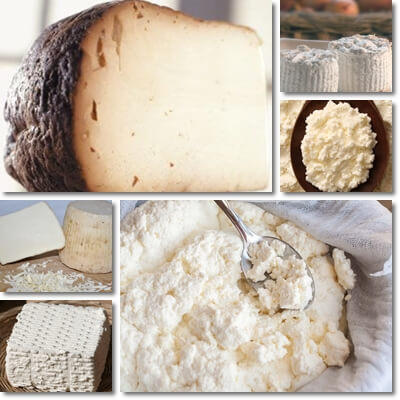Ricotta is a classic Italian cheese known worldwide for its fine taste and soft, delicate texture. But did you know there are about 13 different types of ricotta cheese? There’s the original Italian ricotta made from whey, the US variety made from milk and a ricotta made from whey and milk. There’s Italian water buffalo whey ricotta, cow whey, sheep whey and goat whey ricotta. There’s whole milk and skim milk ricotta, fresh and aged ricotta, plain and smoked ricotta.
And a couple more other unofficial varieties that are starting to gain popularity. Since there are so many different types of the traditional Italian cheese, chances are, when someone says they’ve eaten ricotta, they might not have eaten the ricotta you have. According to the raw material used, whey or milk or both, fat content and type of milk and freshness factor, the following varieties exist:

1) Italian water buffalo whey ricotta
This is the original, traditional Italian ricotta recipe. The cheese is made using whey from Italian water buffalo milk (whey is the residual liquid left over after making cheese from milk). What’s interesting to know is that the whey used for this type of ricotta is what’s left after making the famous Italian ‘mozzarella di buffala’, or buffalo mozzarella.
Unlike other varieties, water buffalo whey ricotta is less allergenic because it only contains whey proteins and not casein proteins. It’s overall a good source, providing around 10 g of protein for every 100 g, which accounts for approximately 20% of the entire daily protein requirements of an average adult on a 2000 kcal diet. So if you’re looking to build muscle or simply exercising to lose weight and improve muscle tone and appearance, this ricotta might be exactly what you need to eat after a workout.
With around 10 g of fat per 100 g, it contributes to better looking skin and is food for the brain, in addition to helping you gain muscle.
2) Cow whey ricotta
Since water buffaloes were less common than cows in the past, whey ricotta from water buffalo was produced in limited amounts. To meet growing demands, cow whey ricotta was also produced. Both varieties are representative of traditional ricotta and hold a similar nutritional profile. The most notable nutrition facts of ricotta from cow whey include a good protein and fat content (around 10% of solids), good mineral profile with plenty of calcium, phosphorus and sodium for bones and cardiovascular system and great vitamin B12 content for brain and energy metabolism.

3) Sheep whey ricotta
Also called ‘ricotta romana’, ricotta made from whey from sheep milk is actually a better established variety than the traditional cow and water buffalo whey one. As of 2005, ricotta romana is protected by EU legislation under the PDO, Protected Designation of Origin label or DOP, Denominazione di Origine Protetta. The variety is made from whey from whole sheep’s milk (sometimes with the addition of limited amounts of whole sheep milk)
The milk can only come from sheep raised on pastures in the Lazio region of Italy for the cheese to receive its PDO or DOP label. Also, the cheese variety must comply with a strict manufacturing process.
Ricotta romana is an important source of protein and fat and contains good amounts of healthy Omega-3 fatty acids with antioxidant and anti-inflammatory properties and benefits for the brain and vascular system. The fact that the sheep are pasture-raised is what contributes to the good Omega-3 values and a good content of conjugated linoleic acid, a type of Omega 6 fatty acid. There are studies showing conjugated linoleic acid has anti-cancer properties and provide benefits for weight loss.
4) Goat whey ricotta
Limited amounts of ricotta from goat whey are currently being produced as a result of the emerging consumer demand for goat milk mozzarella. However, because goat milk tends to be lower in fat and protein than cow, water buffalo and especially sheep milk, the whey is usually rounded up with whole goat milk. Overall, this ricotta variety is believed to be more easily digestible, although it can cause bloating, flatulence and loose stools for those severely lactose intolerant as it still contains lactose.
5) Whey and whole milk ricotta (mixed type)
It’s not uncommon for producers to supplement the whey with various amounts of whole milk to obtain a better-tasting, cost-effective ricotta. Usually, there is significantly more whey than whole milk used in the original ricotta recipes. For the most part, the nutritional profile is similar to that of whey ricotta.
6) Whole milk ricotta
Modern-day ricotta is typically made from whole milk, usually cow milk, but also buffalo, goat and sheep (to a lesser extent). In some parts of the world, whole milk ricotta is considered the original variety. Compared to whey varieties, whole milk ricotta is more allergenic because it contains the milk protein casein. The use of whole milk is meant to improve texture and taste, giving the fresh cheese richer flavors. At the same time, the richer flavor comes at a cost: higher fat content and energetic value.
Depending on the brand and type of milk used as well as degree of standardization of the production process, some cheeses may provide as little as 7-8 g of fat per 100 g, while others 13-18 g of fat per 100 g. But unless you eat too much too frequently, there should be mostly beneficial health effects. Whole milk ricotta is also generally a better source of potassium than low-fat varieties which is great for blood pressure control.
7) Part skim milk ricotta
Typically uses skim cow milk, or may use whey from cow milk and skim/whole cow milk. It’s also called ‘light ricotta’ because of its lower fat content and energetic value. However, this variety doesn’t necessarily have less fat than whey and some whole milk ricotta types (some brands do, some don’t). It’s important to read the label for nutritional information to determine exactly how much of what nutrients you will get.
In case it’s really part skim, you may get roughly 2 less grams of fat and 2-4 more grams of protein per 100 g. Ricotta made from part skim milk tends to have more potassium as well as slightly more calcium and phosphorus compared to whole milk varieties. Sodium content tends to remain the same since it’s often the producers that maintain a certain sodium level in ricotta to achieve a standard taste.
8) Ricotta salata (salted), secca (dried), stagionata (aged)
It’s basically what it’s called: a salted, dried ricotta that is allowed to age for up to several months or even a year. The aging process increases flavor profile and dries out the ricotta which makes it more crumbly and allows it to be grated. The variety maintains its milky-white appearance, but develops a more complex, yet clean flavor profile. Because it’s salted, it’s best to avoid eating too much too frequently if you have high blood pressure. At the same time, as the ricotta ages, the lactose content drops to 2-3% or more which makes it good to eat if you have lactose intolerance.
Ricotta salata al peperoncino (meaning salted ricotta with pepper) is a sub-type of aged ricotta with chili peppers. While it gives a unique piquant, sharp taste to the aged cheese, it’s bad for anyone with gastritis, acid reflux or hemorrhoids if eaten in large amounts or too frequently.
9) Ricotta in forno, infornata, or baked ricotta
A large piece of the soft cheese is baked to various degrees to enhance its flavor profile. Sometimes various herbs are used to add unique flavors. The baked cheese also develops a moderate yellowish-brown or orange brown crust, but stays whitish on the inside. If baked for longer, it becomes charred on the outside and tan on the inside. The variety maintains its nutritional value, but it’s best to avoid eating the burnt crust.
10) Ricotta affumicata, or smoked ricotta
As its name suggests, it’s a smoked cheese variety. This type of ricotta takes on a burnt, woody aroma and rich flavor profile. But while very much liked for its newly acquired flavors, it’s best not eaten too frequently as research shows smoked foods may increase risks of various cancers. When you do eat it, remove the dark crust.
11) Ricotta forte (scanta)
It’s a salted and aged, soft ricotta variety. It’s made from residual ricotta that is mixed together, salted and aged for months, allowed to ferment. The fermentation process allows for a lower lactose content and gives the cheese a strong, pungent, almost spicy, sharp taste similar to that of blue cheeses like Gorgonzola. Color changes from milky white to cream. As a naturally fermented cheese variety, this particular type of ricotta hold probiotic properties with benefits for the digestive system.
12) Salted vs unsalted ricotta
All types of ricotta contain sodium naturally from whey or milk. Depending on the manufacturer, additional salt may be added to obtain a certain taste, but amounts vary greatly between brands and types. Check the label for more information. Ideally, the healthiest is ricotta without added salt as it provides sufficient sodium naturally and contributes to healthier blood pressure levels.
13) Processed vs home-made ricotta
Processed ricotta can be obtained as a result of a standardized production process, but which maintains the ingredients, properties and quality of the original ricotta. At the same time, it can refer to a variety of processed ricotta containing vinegar (acidifying agent), thickening agents (guar gum, xanthan gum, locust bean gum or carob gum) and other food additives. Lastly, home-made ricotta refers to a fresh type of cheese obtained by heating whey or whole milk and inducing coagulation with the help of acidifying agents such as white vinegar or lemon juice.
Conclusion
Considering there are about 13 different types of ricotta cheese, and a couple of unofficial varieties, you can say ‘ricotta’ has become somewhat of a generic term designating more than one cheese or different takes on the same cheese. And it’s alright since there are benefits to enjoy from every one of them. Not to mention having so many choices is good because it gives life a little more flavor and expands our culinary horizon. It’s just that when someone now says they’ve eaten ricotta, you might be thinking which kind? and was it as good as the ricotta you’ve eaten?
